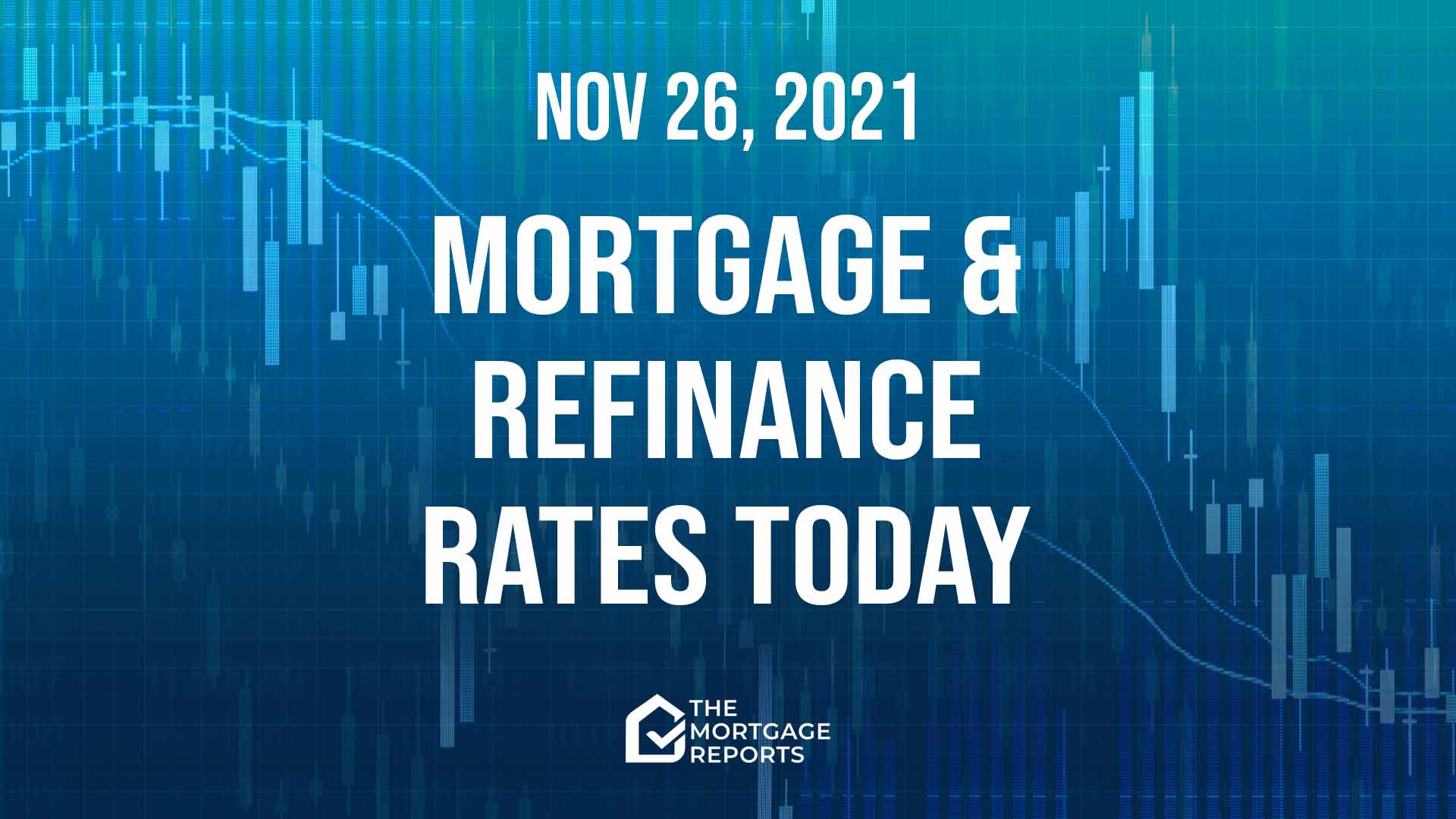
Today’s mortgage and refinance rates
Average mortgage rates inched higher on Wednesday. But it was such a tiny rise that it shouldn’t bother you.
And it’s looking as if mortgage rates today might fall sharply. That seems to be down to new fears about a COVID-19 resurgence, following the emergence of a new variant in southern Africa.
Find your lowest rate. Start here (Nov 26th, 2021)Current mortgage and refinance rates
| Program | Mortgage Rate | APR* | Change |
|---|---|---|---|
| Conventional 30 year fixed | |||
| Conventional 30 year fixed | 3.426% | 3.444% | -0.03% |
| Conventional 15 year fixed | |||
| Conventional 15 year fixed | 2.829% | 2.859% | Unchanged |
| Conventional 20 year fixed | |||
| Conventional 20 year fixed | 3.278% | 3.314% | -0.05% |
| Conventional 10 year fixed | |||
| Conventional 10 year fixed | 2.782% | 2.839% | Unchanged |
| 30 year fixed FHA | |||
| 30 year fixed FHA | 3.546% | 4.315% | Unchanged |
| 15 year fixed FHA | |||
| 15 year fixed FHA | 2.852% | 3.5% | Unchanged |
| 5/1 ARM FHA | |||
| 5/1 ARM FHA | 2.753% | 3.278% | Unchanged |
| 30 year fixed VA | |||
| 30 year fixed VA | 3.393% | 3.589% | Unchanged |
| 15 year fixed VA | |||
| 15 year fixed VA | 3.015% | 3.359% | Unchanged |
| 5/1 ARM VA | |||
| 5/1 ARM VA | 2.606% | 2.51% | Unchanged |
| Rates are provided by our partner network, and may not reflect the market. Your rate might be different. Click here for a personalized rate quote. See our rate assumptions here. | |||
Should you lock a mortgage rate today?
On Wednesday, I wrote, “There’s little sign yet of mortgage rates falling in response to higher daily COVID-19 infections.” Well, that may change today. Read on for the news that might cause mortgage rates to fall, perhaps sharply.
It’s much too soon for me to change my personal rate lock recommendations to reflect information that’s still emerging. But you should weigh that new information when deciding whether or not to follow my advice. Certainly, I wouldn’t lock today.
But, for now, those rate lock recommendations remain:
- LOCK if closing in 7 days
- LOCK if closing in 15 days
- LOCK if closing in 30 days
- LOCK if closing in 45 days
- LOCK if closing in 60 days
>Related: 7 Tips to get the best refinance rate
Market data affecting today’s mortgage rates
Here’s a snapshot of the state of play this morning at about 9:50 a.m. (ET). The data, compared with roughly the same time on Wednesday, were:
- The yield on 10-year Treasury notes tumbled to 1.52% from 1.68%. (Very good for mortgage rates.) More than any other market, mortgage rates normally tend to follow these particular Treasury bond yields
- Major stock indexes were sharply lower soon after opening. (Good for mortgage rates.) When investors are buying shares they’re often selling bonds, which pushes prices of those down and increases yields and mortgage rates. The opposite may happen when indexes are lower. But this is an imperfect relationship
- Oil prices fell to $72.87 from $78.47 a barrel. (Good for mortgage rates*.) Energy prices play a large role in creating inflation and also point to future economic activity.
- Gold prices rose to $1,800 from $1,783 an ounce. (Neutral for mortgage rates*.) In general, it is better for rates when gold rises, and worse when gold falls. Gold tends to rise when investors worry about the economy. And worried investors tend to push rates lower
- CNN Business Fear & Greed index — plummeted to 42 from 57 out of 100. (Good for mortgage rates.) “Greedy” investors push bond prices down (and interest rates up) as they leave the bond market and move into stocks, while “fearful” investors do the opposite. So lower readings are better than higher ones
Caveats about markets and rates
Before the pandemic and the Federal Reserve’s interventions in the mortgage market, you could look at the above figures and make a pretty good guess about what would happen to mortgage rates that day. But that’s no longer the case. We still make daily calls. And are usually right. But our record for accuracy won’t achieve their former high levels until things settle down.
So use markets only as a rough guide. Because they have to be exceptionally strong or weak to rely on them. But, with that caveat, mortgage rates today look likely to fall significantly. But be aware that “intraday swings” (when rates change direction during the day) are a common feature right now.
Find your lowest rate. Start here (Nov 26th, 2021)Important notes on today’s mortgage rates
Here are some things you need to know:
- Typically, mortgage rates go up when the economy’s doing well and down when it’s in trouble. But there are exceptions. Read ‘How mortgage rates are determined and why you should care
- Only “top-tier” borrowers (with stellar credit scores, big down payments and very healthy finances) get the ultralow mortgage rates you’ll see advertised
- Lenders vary. Yours may or may not follow the crowd when it comes to daily rate movements — though they all usually follow the wider trend over time
- When daily rate changes are small, some lenders will adjust closing costs and leave their rate cards the same
- Refinance rates are typically close to those for purchases. And a recent regulatory change has narrowed a gap that previously existed
So a lot is going on here. And nobody can claim to know with certainty what’s going to happen to mortgage rates in coming hours, days, weeks or months.
Are mortgage and refinance rates rising or falling?
The main story in The Guardian (published in London, England) overnight concerned a new (possibly the “worst ever”) variant of COVID-19 that’s just emerged in South Africa. Scientists are still determining how scary that B.1.1.529 variant is. But it’s sufficiently worrying that England has banned flights from that country and five others in the region.
A Guardian story says:
B.1.1.529 has a very unusual constellation of mutations, which are worrying because they could help it evade the body’s immune response and make it more transmissible, scientists have said. Any new variant that is able to evade vaccines or spread faster than the now-dominant Delta variant might pose a significant threat as the world emerges from the pandemic.
— The Guardian, “What do we know about the new ‘worst ever’ Covid variant?” Nov. 25, 2021
Meanwhile, the lead story in The Washington Post overnight ran under the headline, “As cases climb in Americas, health agency warns Europe’s covid surge could be ‘window into the future.'”
And it went on to quote Carissa F. Etienne, who’s director of the Pan American Health Organization. During a Wednesday briefing, she said:
Time and again, we’ve seen how the infection dynamics in Europe are mirrored here several weeks later. The future is unfolding before us, and it must be a wake-up call for our region because we are even more vulnerable.”
— The Washington Post, “As cases climb in Americas, health agency warns Europe’s covid surge could be ‘window into the future’,” Nov. 25, 2021
What this might mean for mortgage rates
As I’ve noted several times recently, all the forces that have been pushing mortgage rates higher over recent months have been based on the current, impressive economic recovery. And that’s been reliant on the dwindling effects of the COVID-19 pandemic.
If we see a significant resurgence in COVID-19 over the winter, mortgage rates may well fall. And, if that resurgence includes a new, deadlier coronavirus variant that proves resistant to vaccines, those rates might tumble, perhaps to new all-time lows.
But don’t get too scared about the economy or too hopeful about lower mortgage rates yet. Scientists are still in the earliest stages of their investigations into B.1.1.529. And it may prove much less worrying than they currently fear.
Meanwhile, the US economy might prove significantly more resilient to a new wave of infections than it was last winter, given the higher number (59.1%) of Americans who have been vaccinated.
In other words, watch this space.
Further ahead
So what happens if the B.1.1.529 variant turns out to be nothing to worry about? And if the possible winter wave of coronavirus infections turns out to cause a mere ripple in the recovery?
Well, then I’d expect mortgage rates to continue to drift gently higher, partly based on four reasons that emerged in reports on Wednesday:
- The Federal Reserve minutes showed the Fed actively considering tapering its purchases of mortgage bonds more quickly than announced
- Initial claims for unemployment insurance last week were at their lowest level since Nov. 15, 1969. That’s a 52-year low!
- Inflation measures published that day were warmer than — or as warm as — expected
- Gross domestic product (GDP) growth was robust
Each of these would normally act to push mortgage rates higher. But not if COVID-19 fears swamp markets.
You can also read last Saturday’s weekend edition for more general background.
Recently
Over much of 2020, the overall trend for mortgage rates was clearly downward. And a new, weekly all-time low was set on 16 occasions last year, according to Freddie Mac.
The most recent weekly record low occurred on Jan. 7, when it stood at 2.65% for 30-year fixed-rate mortgages.
Since then, the picture has been mixed with extended periods of rises and falls. Unfortunately, since September, the rises have grown more pronounced, though not consistently so.
Freddie’s Nov. 24 report puts that weekly average for 30-year, fixed-rate mortgages at 3.1% (with 0.7 fees and points), unchanged from the previous week.
Expert mortgage rate forecasts
Looking further ahead, Fannie Mae, Freddie Mac and the Mortgage Bankers Association (MBA) each has a team of economists dedicated to monitoring and forecasting what will happen to the economy, the housing sector and mortgage rates.
And here are their current rate forecasts for the remaining, current quarter of 2021 (Q4/21) and the first three quarters of 2022 (Q1/22, Q2/22 and Q3/22).
The numbers in the table below are for 30-year, fixed-rate mortgages. Fannie’s were published on Nov. 18 and the MBA’s on Nov. 22.
Freddie’s were released on Oct. 15. It now updates its forecasts only quarterly. So we may not get another from it until January.
| Forecaster | Q4/21 | Q1/22 | Q2/22 | Q3/22 |
| Fannie Mae | 3.1% | 3.2% | 3.3% | 3.3% |
| Freddie Mac | 3.2% | 3.4% | 3.5% | 3.6% |
| MBA | 3.1% | 3.3% | 3.5% | 3.7% |
However, given so many unknowables, the whole current crop of forecasts may be even more speculative than usual.
All these forecasts expect at least modestly higher mortgage rates fairly soon.
Find your lowest rate today
Some lenders have been spooked by the pandemic. And they’re restricting their offerings to just the most vanilla-flavored mortgages and refinances.
But others remain brave. And you can still probably find the cash-out refinance, investment mortgage or jumbo loan you want. You just have to shop around more widely.
But, of course, you should be comparison shopping widely, no matter what sort of mortgage you want. As federal regulator the Consumer Financial Protection Bureau says:
Shopping around for your mortgage has the potential to lead to real savings. It may not sound like much, but saving even a quarter of a point in interest on your mortgage saves you thousands of dollars over the life of your loan.
Verify your new rate (Nov 26th, 2021)Mortgage rate methodology



